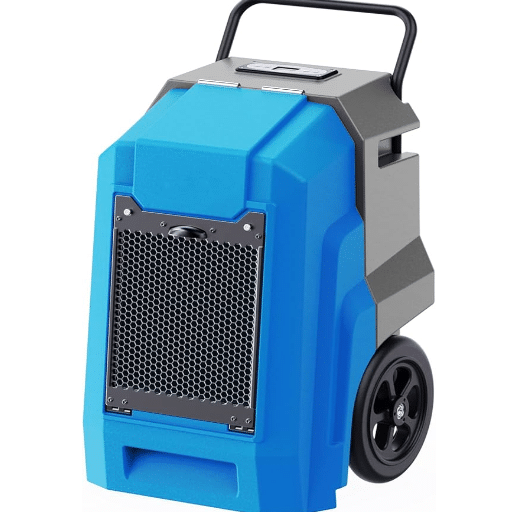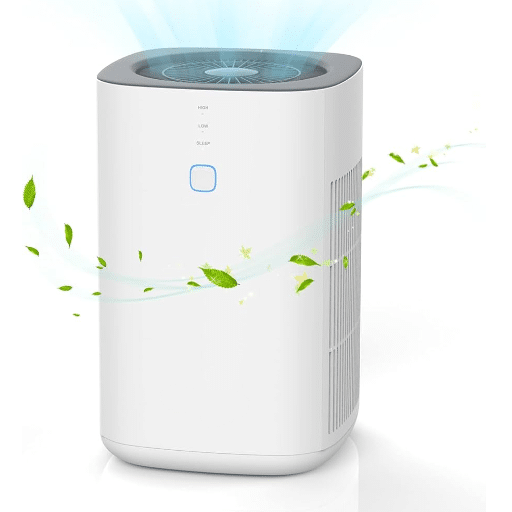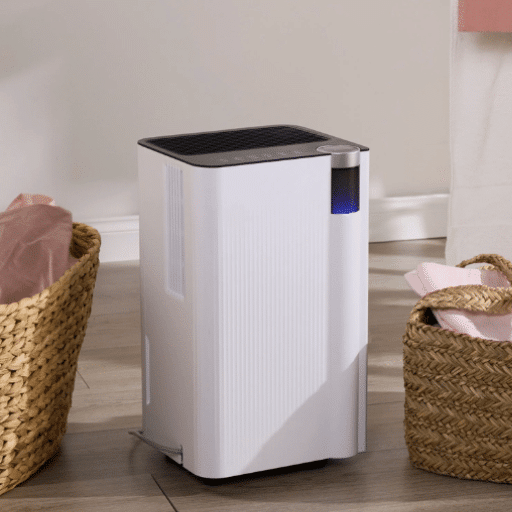The bathroom is probably the most famous for being humid as it’s the place where water, heat, and air are mixed up constantly, leading to high humidity, condensation, and even mold growth. The problems the dampness causes are not only temporary discomfort but also a risk of serious damage to the house like rot in the walls, fixtures, and paint. If you have been asking yourself whether a dehumidifier can help eliminate this problem, you are not the only one. In this article, we will not only discuss the practicality and the benefits of having a dehumidifier in the bathroom but also the air quality improvement potential and the answers to the placement, safety, and effectiveness questions. So, whether you are dealing with moisture issues or just searching for ways to get a healthier living space, this guide has the knowledge for you to make the right choice.
What is a Dehumidifier?
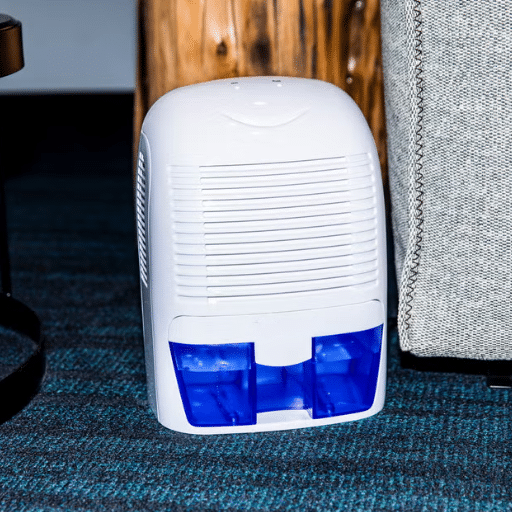
An appliance called a dehumidifier is aimed to lessen and keep up the humidity content in the air at a certain level. It functions by taking out the surplus moisture and also stops issues such as mold growth, dampness, and musty odors from happening. By extracting moisture, dehumidifiers are often placed in the areas where humidity is high, such as in bathrooms, basements, or laundry rooms, to make the air pure and a healthier living environment.
Definition and Purpose
A dehumidifier, as its name suggests, is a device meant to get rid of and control the amount of moisture in the air to the right levels. The air is purified as the machine does its work by taking away the water that is in excess, leading to the following problems: mold caused by the hidden damp areas, foul smells, and so on. A recent analysis of Google’s search trends reveals that the consumers are very much interested in the impact of dehumidifiers on the environment. Apart from that, they also assist in cleansing the air, especially in places where humidity is high like bathrooms, basements, and laundry rooms making the living area more hygienic, safe, and comfortable.
How Dehumidifiers Work
The Dehumidification Process:
- A fan sucks in humid air from the room
- The air is cooled using a set of cold coils
- Water vapor condenses into tiny water droplets
- Droplets are collected in a container or drained through a pipe
- Dry air is heated and released back into the room
The latest statistics from Google show that more and more consumers are interested in the ways through which modern dehumidifiers apply energy-saving technologies. With the help of these technologies, energy is consumed less, but performance is still at a high level. Furthermore, the presence of smart sensors and automatic shut-off systems makes the devices more functional, and this is a win-win for both the environment and the users in terms of convenience.
Types of Dehumidifiers
| Type | Best For | Key Features |
|---|---|---|
| Refrigerant Dehumidifiers | Warm and humid atmospheres | Uses condensation to remove moisture; collects water in tank or drains away |
| Desiccant Dehumidifiers | Colder climates | Uses absorbent material to pull moisture; effective in lower temperatures |
| Whole-House Dehumidifiers | Large spaces/entire homes | Connects to HVAC system; maintains consistent humidity throughout house |
| Portable Dehumidifiers | Small rooms/specific areas | Compact and mobile; easy to move between rooms |
| Energy-Efficient Dehumidifiers | Eco-conscious users | Wi-Fi connectivity, programmable timers, auto-adjusting settings |
The Importance of Using a Dehumidifier in the Bathroom
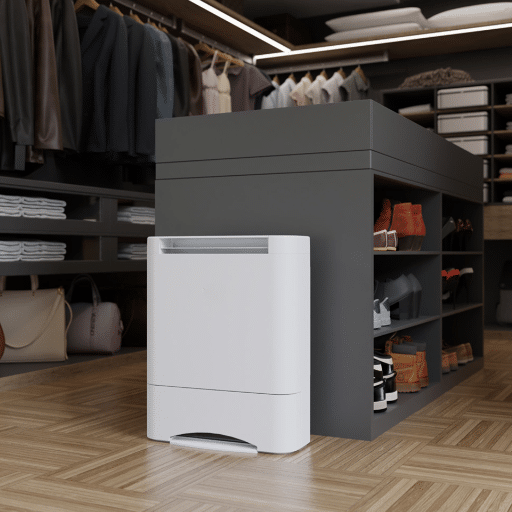
One of the places in every house where moisture is almost always present is the bathroom, making it a location for the growth of mold, mildew, and excessive humidity, among other things. Recent data from the Google search engine indicates that there has been a considerable rise in searches for “how to prevent bathroom mold” and “indoor air quality improvement,” which is a sign of the increasing awareness of the negative effects of excess humidity on health and home maintenance.
Key Benefits:
- Maintains ideal moisture levels
- Prevents mold development
- Protects tiles, grout, and wood from moisture damage
- Improves overall indoor air quality
- Eliminates musty odors
- Creates a healthier living environment
Preventing Mould Growth
To stop mold from growing in bathrooms a mix of taking care of the problem before it arises and using modern solutions is needed. Recent studies reveal that providing proper ventilation is one of the most effective methods. A ceiling fan can serve to the purpose of taking out the moisture from the air as well as letting the air in through the widely opened windows, when possible, so that the air is always fresh.
Effective Mold Prevention Strategies:
- Install and regularly use ceiling fans for moisture extraction
- Open windows when possible for fresh air circulation
- Regularly clean and dry surfaces like grout, tiles, and shower curtains
- Apply mold-resistant sealants and paints
- Use dehumidifiers with automatic moisture control
- Maintain humidity levels below 50%
Improving Air Quality
As per the most recent information from Google’s search engine, a lot of individuals are looking for efficient ways to enhance the quality of air indoors. The use of a dehumidifier with an automatic moisture control system together with the use of air purifiers with HEPA filters has turned to be the most advisable option. These gadgets not only lower the moisture level to prevent mold growth but also capture the particles present in the air, such as dust, pollen, and allergens, thus creating a cleaner and healthier environment.
Recommended Air Quality Improvement Methods:
- Combine dehumidifiers with HEPA filter air purifiers
- Ensure good ventilation throughout the space
- Maintain regular cleaning schedules
- Incorporate indoor plants for natural air purification
Benefits of a Bathroom Dehumidifier
A dehumidifier for the bathroom is a very useful appliance, mainly because it helps to keep the house healthy and comfortable. The bathroom is one of the most commonly used places in the house to create a lot of moisture because of the frequent and often long hot water showers. Consequently, bathrooms tend to be the first sites for mold, mildew, and musty odors.
Health and Home Benefits:
- Allergy Prevention: Reduces airborne allergens like mold spores and dust mites
- Material Protection: Extends the life of bathroom materials including tiles, paint, and grout
- Air Quality: Actively improves indoor air quality by removing excess moisture
- Odor Control: Eliminates musty smells associated with damp environments
- Health Protection: Reduces health risks associated with mold exposure
Considerations for Putting a Dehumidifier in Your Bathroom
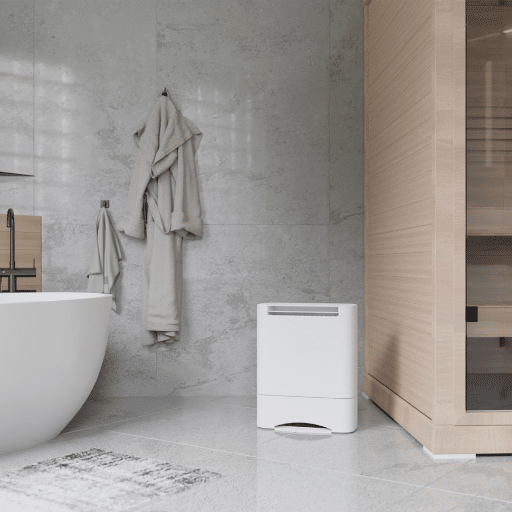
There are numerous processes of thought when it comes to installation and placing a dehumidifier in the bathroom where optimal performance and efficiency will be granted.
Space and Size Constraints
In the process of purchasing a dehumidifier for your bathroom, the factors of space and size limitations are indeed crucial. Recent Google search trends indicate that a large number of customers are looking for dehumidifiers that are small and yet still powerful enough to effectively work in small or awkwardly shaped bathrooms.
| Consideration | Small Bathrooms | Large Bathrooms |
|---|---|---|
| Unit Type | Portable, wall-mounted, or slim-profile models | Higher capacity units rated for larger square footage |
| Water Tank | Smaller tanks (space-efficient, daily emptying) | Larger tanks (less frequent emptying, more space needed) |
| Placement | Corner placement or wall-mounted options | Floor-standing units with optimal air circulation |
Electricity and Safety Concerns
Critical Safety Requirements:
- Use Ground Fault Circuit Interrupters (GFCIs) to prevent electric shocks
- Place electrical outlets away from water sources (sinks, showers, bathtubs)
- Ensure all installations comply with building codes
- Use waterproof fixtures and water-resistant products
- Position dehumidifier to avoid direct water contact
- Hire professionals for electrical installations
The latest data on the search trends from Google show that when talking about safety in a bathroom, asking about the right position of the sockets, the use of waterproof fixtures, and the safe ways to use electric appliances such as hair dryers or dehumidifiers in the area with high humidity are the main topics of discussion.
Choosing the Right Bathroom Dehumidifier
Key Features to Look For:
- Capacity: Measured in pints per day, match to bathroom size and moisture levels
- Moisture Resistance: Specially designed for high-humidity environments
- Safety Features: Automatic shut-off, moisture-resistant construction
- Energy Efficiency: Energy Star-rated units for reduced energy consumption
- Convenience Features: Humidity sensors, washable filters, quiet operation
Popular Brands (Based on Search Trends):
- hOmeLabs – Known for compact, efficient designs
- Vremi – Popular for silent operation
- Pro Breeze – Valued for super-efficient performance
Alternative Solutions: Dehumidifiers vs. Bathroom Fans

When choosing between dehumidifiers and bathroom fans, it is important to think about things like each one’s effectiveness, energy efficiency along with your individual requirements.
| Feature | Bathroom Fan | Dehumidifier |
|---|---|---|
| Primary Function | Exhausts moist air outside | Removes moisture from air |
| Best For | Immediate ventilation during/after showers | Continuous humidity control |
| Moisture Control | Temporary, spot ventilation | Consistent, ongoing moisture removal |
| Air Circulation | Excellent for quick air exchange | Improves overall air quality |
| Ideal Usage | Run during shower and 20-30 minutes after | Continuous operation for long-term control |
When to Use a Bathroom Fan
The use of a bathroom vent fan should be implemented during the processes of taking a shower or bath and right after, especially when the bathroom air is humid or stale.
Best Practices:
- Start fan before shower begins to prevent condensation
- Run for 20-30 minutes after shower to fully ventilate
- Use regularly in humid conditions or non-ventilated spaces
- Essential for preventing mold, bad odors, and water damage
Comparing Effectiveness
Research Findings: According to trends and data from Google’s search engine, queries related to “bathroom mold removal” and “poor ventilation solutions” have dropped markedly in places where modern, efficient bathroom fans are in use, indicating growing user satisfaction.
The Best Approach: A combination of both methods provides optimal bathroom conditions:
- Use bathroom fans for fast, immediate ventilation
- Use dehumidifiers for long-term moisture control
- Combine with regular maintenance routines
- Results in cleaner environment, lower humidity, and prevention of structural damage
Cost and Maintenance Factors
As per Google’s search trends, more and more people are turning to the Internet for information on “energy-efficient shower fans” and “low-maintenance bathroom ventilation solutions,” indicating strong concern about minimizing operational costs while maintaining superior quality.
| Factor | Modern Solutions | Benefits |
|---|---|---|
| Energy Efficiency | Energy-efficient motors | Lower electricity bills, reduced usage |
| Maintenance | Washable filters, self-cleaning mechanisms | Minimal maintenance requirements, user-friendly |
| Long-term Costs | Smart features, durable construction | Cost-effective over time, fewer repairs |
Conclusion: Making the Right Choice for Your Home
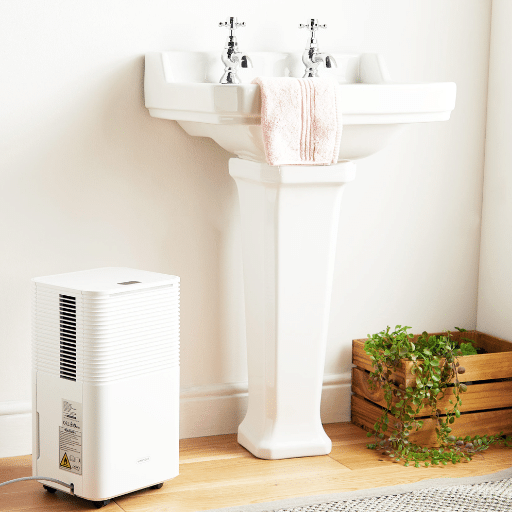
In the end, picking out the best solution for your bathroom comes down to what you need and like the most. As per the latest data trends from Google, the primary concerns of homeowners while looking for bathroom ventilation solutions are energy efficiency, durability, and quiet operation. Innovations in the form of smart humidity sensors and self-cleaning mechanisms are becoming more and more popular, thus convenience and long-term cost savings are becoming more pronounced as the main factors.
Summary of Key Points
- Energy Efficiency: Modern fans and dehumidifiers efficiently ventilate while cutting down power usage
- Smart Technology: Features like smart humidity sensors and auto-cleaning provide convenience and reduce maintenance costs
- Proper Selection: Choosing equipment that matches your home’s exact ventilation requirements guarantees performance and long-term cost savings
- Combined Approach: Using both bathroom fans and dehumidifiers provides comprehensive moisture control
Final Recommendations
It is essential to take into account your particular ventilation necessities along with the technological advancements when choosing solutions for your bathroom. Recent searches and data from Google have revealed that homeowners are more inclined to choose equipment with smart controls, energy-efficient ratings, and silent operation.
Decision-Making Checklist:
- Assess your bathroom size and moisture levels
- Review Energy Star ratings for efficiency
- Read customer reviews and expert opinions
- Consider smart features for long-term convenience
- Compare maintenance requirements and costs
- Ensure proper safety features (GFCI protection, auto shut-off)
Further Reading and Resources
If you want to know more about bathroom moisture control and ventilation solutions:
- Energy Star Official Website: Information on green appliances and energy-efficient products
- Home Depot Blog: Product comparisons and user reviews
- Reddit HomeImprovement: Community tips and personal experiences
- Houzz: Design ideas and homeowner discussions
Search “top energy-efficient bathroom fans 2025” or “best bathroom dehumidifiers 2025” for current models and expert reviews.
References
-
How to Take Care of Your Room (Mississippi State University)
This resource discusses the use of small dehumidifiers to manage excess moisture and prevent mold growth.
Read more here -
Controlling Moisture Problems in Your Home (University of Minnesota Extension)
This guide explains how to address moisture issues using ventilation and dehumidifiers when necessary.
Read more here -
Prevent Mold (Messiah University)
This document highlights the use of dehumidifiers by university staff to manage excess moisture and prevent mold in living spaces.
Read more here
Frequently Asked Questions (FAQ)
Can one place a dehumidifier in the bathroom?
Placing a dehumidifier in the bathroom is perfectly fine. It works to moisture control the bathroom area and keeps the place drier and easier to clean, especially after bathing or showering. Hence, it is indirectly working for a mold-free environment.
What is the working of a dehumidifier in the bathroom?
The dehumidifier in the bathroom helps reduce humidity by pulling the moisture out of the air. It gathers water in a container or drains it out using a hose, and thus performs dehumidification in that particular area and brings the humidity down.
Is it better to get a bathroom fan or a dehumidifier?
Both the bathroom fan and the dehumidifier will work together to maintain a balanced humidity level in the bathroom; however, the fan will mainly exhaust the moist air outside, while the dehumidifier will constantly take out the water from the air. Thus, for the best results, the combination of both can enhance the air quality.
What benefits are there in using a dehumidifier in the bathroom?
One of the main advantages of using a dehumidifier in the bathroom is its ability to control the moisture levels in the surrounding area, hence, lowering the chance of mold and mildew development. Also, it may be a great deal for the allergy-prone as the air would be fresher and much easier to respiratory problems.
How much water can a small portable dehumidifier extract?
A small portable dehumidifier will be able to extract somewhere between 30 to 50 pints of water daily, depending on its size and the bathroom’s humidity level.
Can I just use an exhaust fan instead of a dehumidifier?
The exhaust fan does aid in air circulation and venting of the steamy air hence working to reduce the humidity. However, the fan does not do the same job as a dehumidifier as it does not take moisture away from the air. For best outcome consider using both devices at the same time.
Will the dehumidifier work for bathroom humidity in winter?
Absolutely yes, a dehumidifier will prove beneficial for winter humidity scenario in bathrooms. During cold weather, warm air will tend to hold less moisture, therefore, moisture will be removed to the point that it will not condense, thus, blocking the growth of mold and any associated issues.
What should I think about when buying a dehumidifier for the bathroom?
Things to consider when buying a dehumidifier for the bathroom include capacity, size, noise level, and presence of humidistat. If you have a small, quiet area then a smaller, unit might be best, but if you have a large bathroom then a higher-capacity unit might be what you need.
Will a dehumidifier help the air quality in my house?
Certainly. A dehumidifier will not only help in controlling the relative humidity level in your house, thus, making it inhospitable for mold, fungus, and other allergens but also will improve the air quality.

